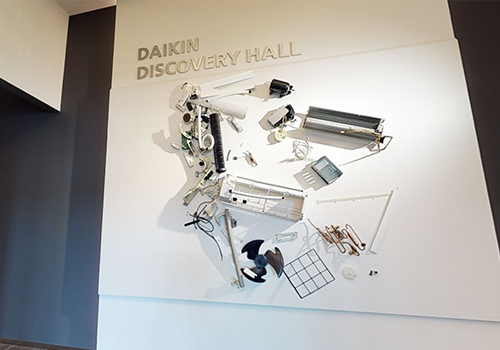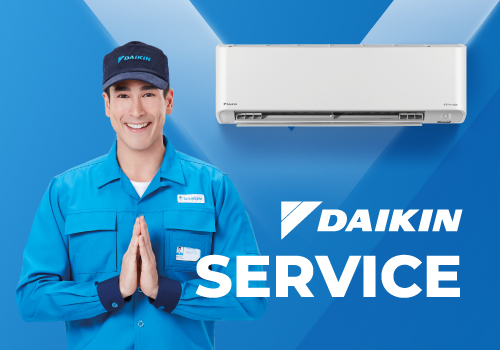EXPERT VENTILATION METHODSFOR OFFICES AND STORES
In recent years, the world has been reexamining the importance of ventilation.
As an air conditioning expert,
Daikin will impart the way of Perfecting the Air through ventilation to help create safe and comfortable spaces.
Effective Ventilation According to Different Scenes
1.Basic Knowledge of Ventilation
2.Tips on Office and Store Ventilation
- 1.Small Stores <Freestanding buildings such as restaurants and shops facing the street>
- 2.Small to Medium-sized Offices <Offices located in small and medium-sized buildings with 10 floors or less>
- 3.Offices and Stores in Large Buildings with Closed Windows
- Summary of Ventilation Methods for Offices and Stores
1.Basic Knowledge of Ventilation
What is ventilation?
Ventilation is the replacement of indoor air with fresh outdoor air in order to dilute and displace air pollutants (substances that are harmful to humans) inside the room of a building.
What are pollutants?
Pollutants (substances that are harmful to humans) include carbon dioxide (CO2), carbon monoxide (CO), formaldehyde (HCHO), house dust, pollen, bacteria, and viruses that exist in indoor air.
Ventilation can be expected to dilute these pollutants and displace them from inside the room of a building.
Why do I have to ventilate?
Ventilation dilutes and displaces pollutants in indoor air.
In a completely closed room of a building, air cannot easily leave the room, causing air pollutants to remain and increase in the room. This situation can impact the health of people in the room.
Ventilation is extremely important for diluting and displacing these air pollutants.
Most air conditioners cannot perform ventilation.
An air conditioner creates a comfortable environment by drawing air from inside the room, cooling or warming it, then returning that air to the room. Indoor air is not replaced by fresh outdoor air.
This is why most air conditioners for stores and offices cannot perform ventilation on their own.
It is necessary to ventilate by means other than an air conditioner.
Offices and Stores Equipped with Ventilation Systems
Buildings that lease space for offices and stores are generally well-ventilated. This is because ventilation equipment is specified by building code according to floor area and the number of people present. Ordinarily, building entrance doors and windows remain closed so that the office workers can work comfortably and efficiently and the customers shopping in the stores can spend their time in comfort.
Large buildings may not have windows or have windows that are impossible to open. For this reason, ventilation equipment is installed to prevent stale air from accumulating in the building. When stores are especially crowded, or when many people attend a meeting in one room, opening windows and doors increases the efficiency of the ventilation equipment to actively change the indoor air. To maximize ventilation, we recommend that you first determine the type of ventilation equipment installed in your office or store and understand how it works and should be operated.
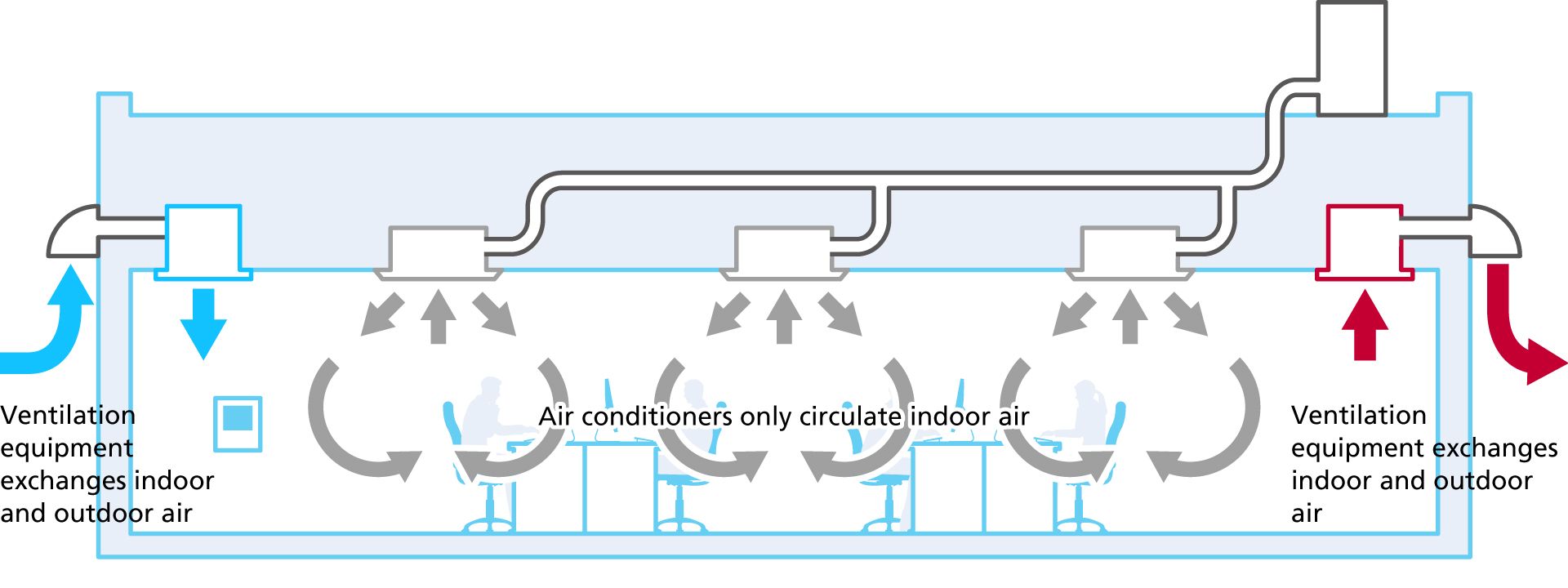
2.Tips on Office and Store Ventilation
Depending on the building where an office or store is located, ventilation equipment may be operated by the building tenants individually or by the building management company. Also, the ventilation method varies according to whether the windows can be opened or not. In Tips on Office and Store Ventilation, we describe ventilation methods according to the following three cases.
1.Small Stores <Freestanding buildings such as restaurants and shops facing the street>
- ①Check the ventilation equipment installed
- ②Create an air passage by opening windows and entrance doors
- Using ventilation equipment with windows and doors open
- Opening windows to create an air passage
- Ventilating rooms without windows (private room)
2.Small to Medium-sized Offices <Offices located in small and medium-sized buildings with 10 floors or less>
- ①Check the ventilation equipment installed
- ②Create an air passage by opening windows and entrance doors
- Using ventilation equipment with windows and doors open
- Opening windows to create an air passage
- Ventilating conference rooms without windows
- Experimental data: CO2 concentration in conference rooms
3.Offices and Stores in Large Buildings with Closed Windows
Summary of Ventilation Methods for Offices and Stores
1.Small Stores <Freestanding buildings such as restaurants and shops facing the street>
Ventilation equipment installed in small stores is mostly operated by their employees who use a remote controller to operate it. Because the air conditioners are typically used to adjust temperature and air volume according to desired warmth and coolness, most people know the locations of the air conditioner and its remote controller, while only a few people may know the location of the ventilation equipment, much less know how to operate it. Ventilation equipment is largely divided into two types: “Stores with ceiling fan ventilation (See Fig. 1)" and “Stores with a heat reclaim ventilator (See Fig. 2)". It is usually installed in a concealed place such as in the ceiling.
Fig. 1 Stores with ceiling fan ventilation
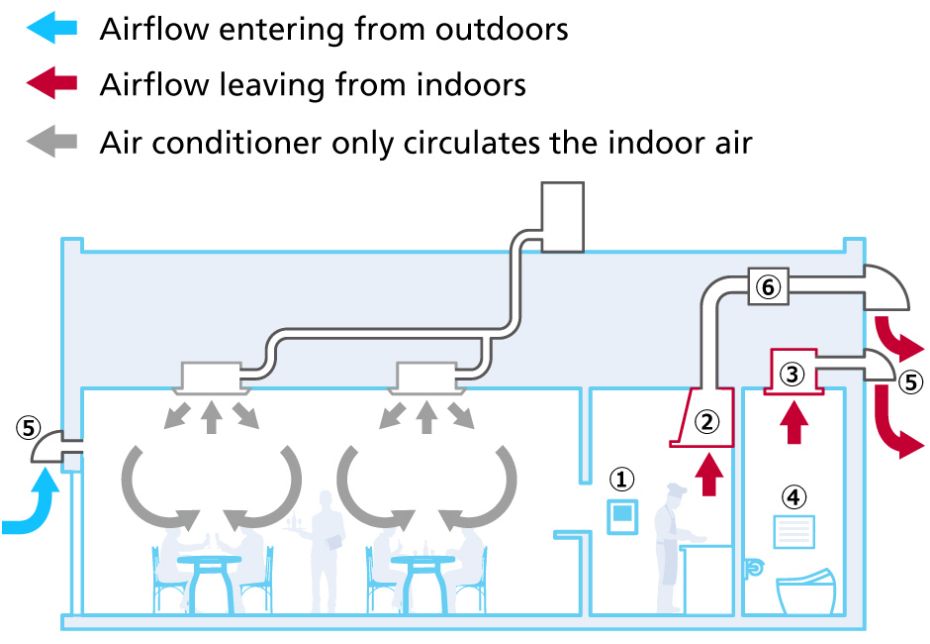
①Remote controller switch ②Ventilation hood ③Ventilation vent (exhaust) ④Door vent ⑤Vent / Vent cap ⑥Heat reclaim ventilator
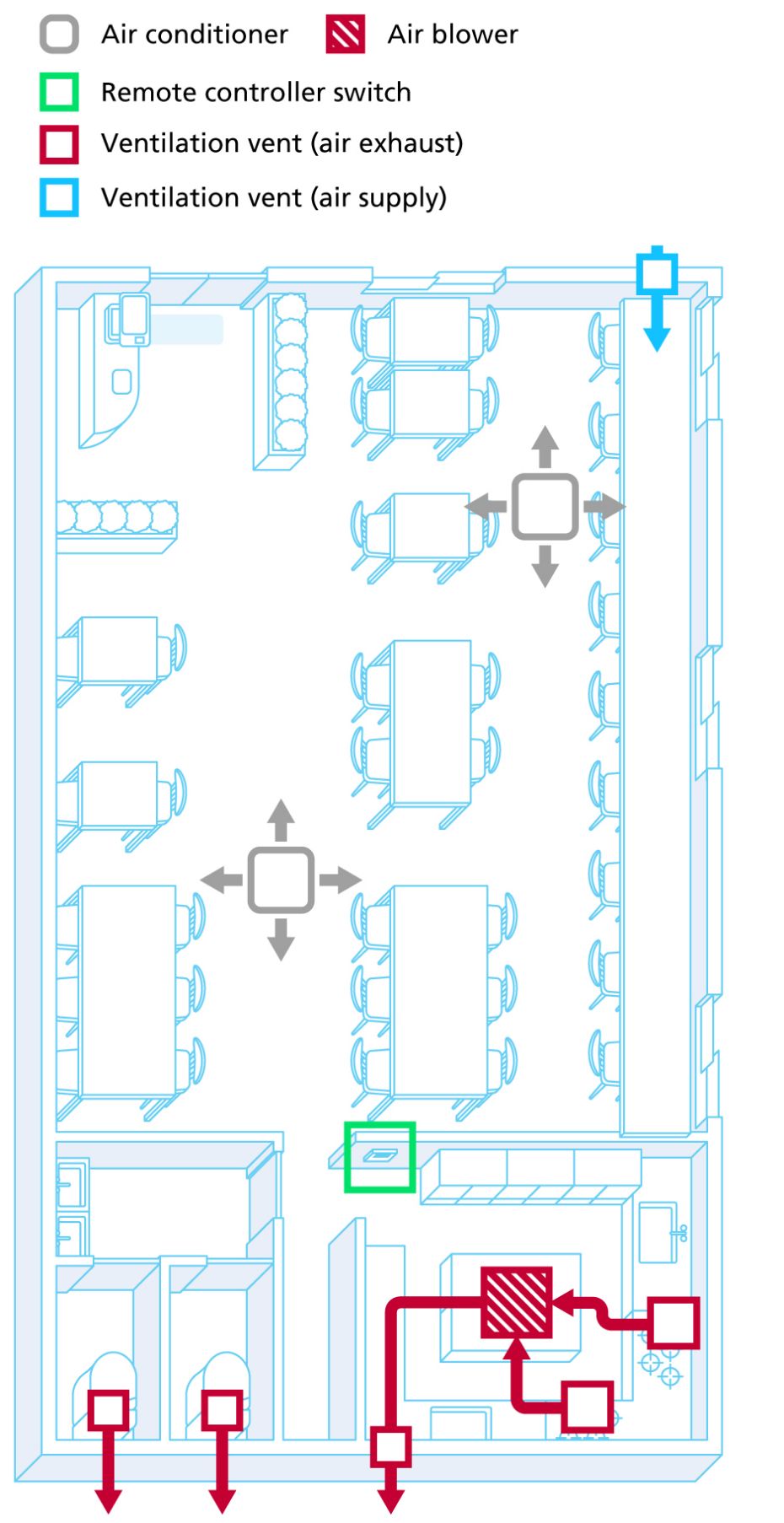
Fig. 2 Stores with a heat reclaim ventilator

①Remote controller switch ②Ventilation hood ③Ventilation vent (exhaust) ④Door vent ⑤Vent / Vent cap ⑥Heat reclaim ventilator

①Check the ventilation equipment installed
First, determine the type of ventilation equipment installed, the location of the remote controller, ventilation equipment, and ventilation vents and understand how the room is ventilated.
Filters are installed behind the vents on the walls and ceilings. When filters become dirty, you may not even notice that ventilation capacity has worsened, but as filters become clogged with dirt, ventilation efficiency decreases. Therefore, it is important to regularly clean or replace them. (Because filters prevent outside insects from coming indoors and protect ventilation equipment, never operate with the filters unattached.)
Also, be sure to check the operation of the remote controller for the ventilation equipment. In many cases, operation is integrated with the air conditioning remote controller. Make sure that the ventilation equipment continues to operate even when cooling or heating is OFF during the mild seasons of spring and autumn.
Examples of Unclean Ventilation Vents and Filters at Small Stores (Restaurants)
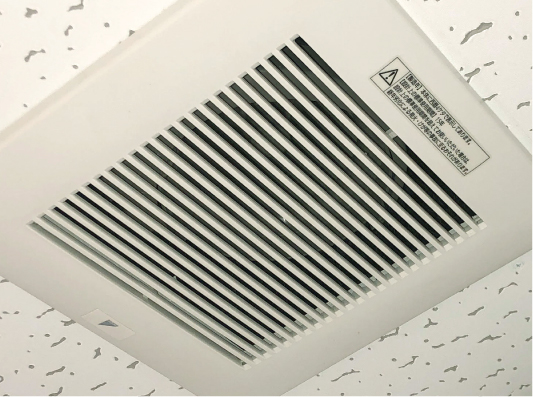
Ceiling vent

Ventilation fan

Outdoor vent
②Create an air passage by opening windows and entrance doors
Using ventilation equipment together with opening windows and doors
The standard length of time and frequency to ventilate a building by opening windows is about 10 minutes every hour. The effect becomes even higher when ventilation is performed twice for five minutes every hour than when it is performed once for ten minutes every hour. In other words, the more often you ventilate, the greater improvement you will see in effectiveness. We recommend ventilating before the start of business hours and during breaktime.
Ventilation by opening windows at a store
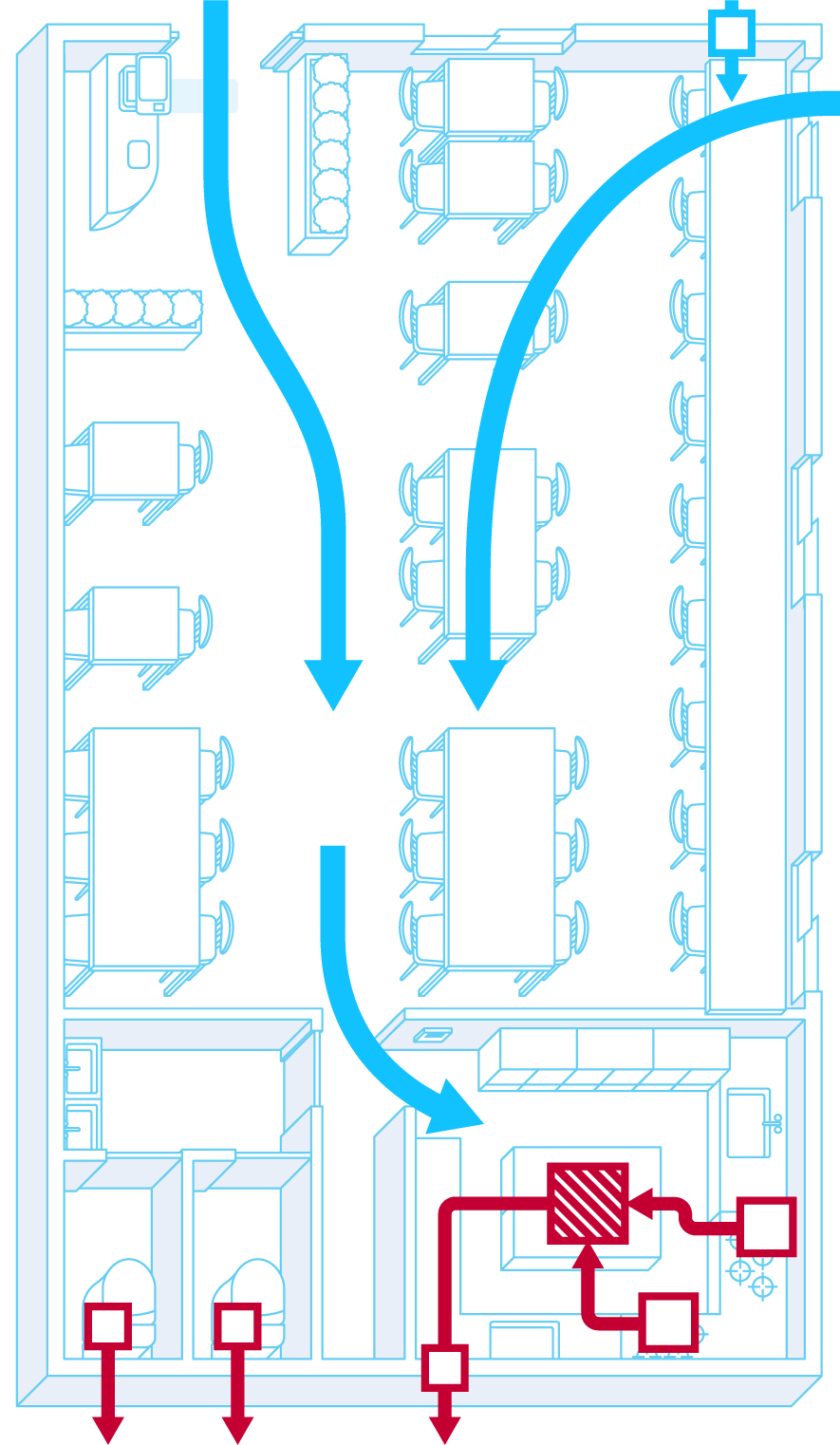
Method for opening windows to create an air passage
When ventilation is performed by opening windows, it is better to open two windows instead of one in order to create an air passage for efficient ventilation. It is even more efficient if the two windows are diagonal to each other.
Good example: It is efficient to open windows that are diagonal to each other.
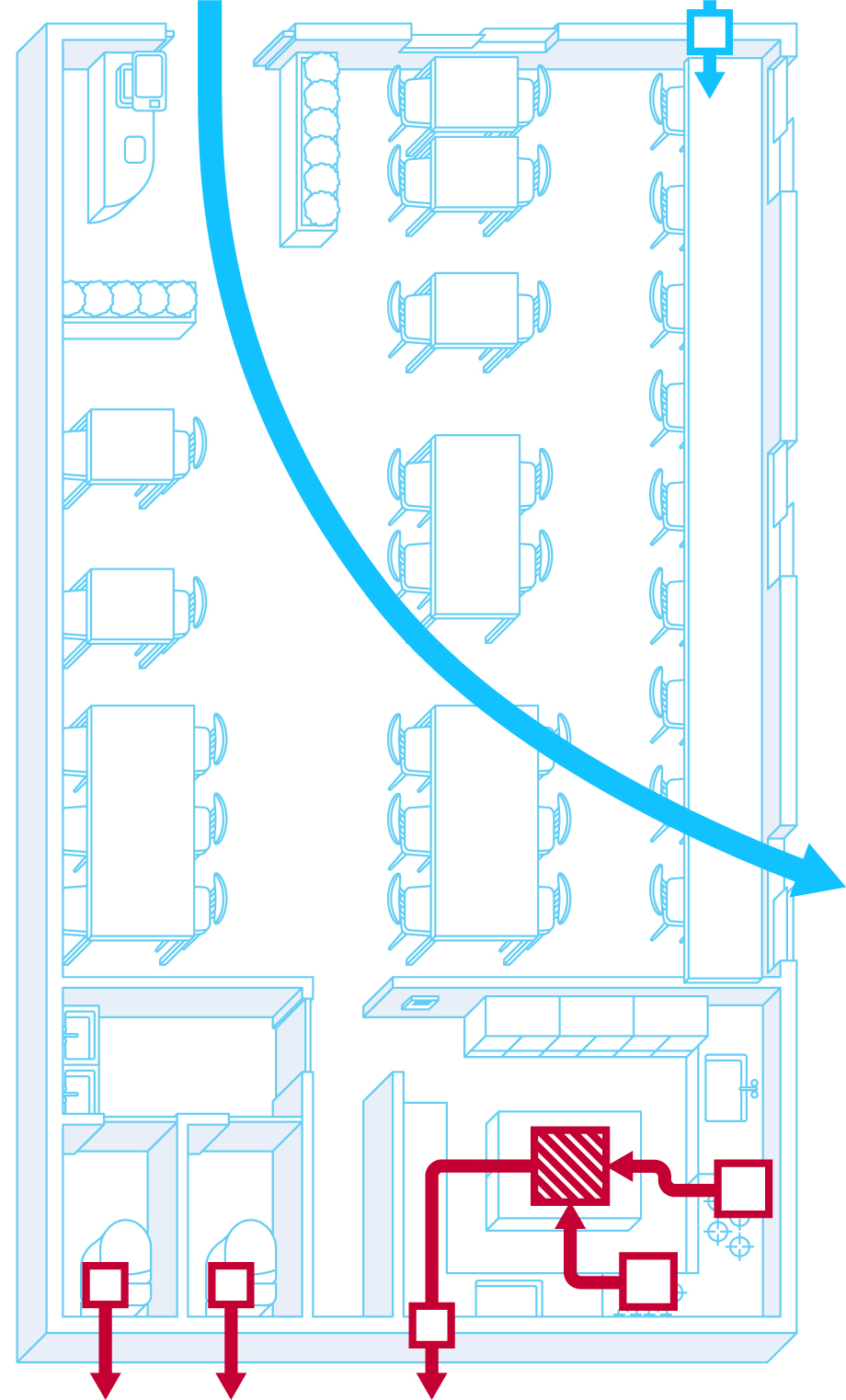
Opening two windows positioned closely to each other will prevent air from flowing through the entire room.
Bad example: Inefficiency results from opening nearby windows due to the small area in which air circulates.
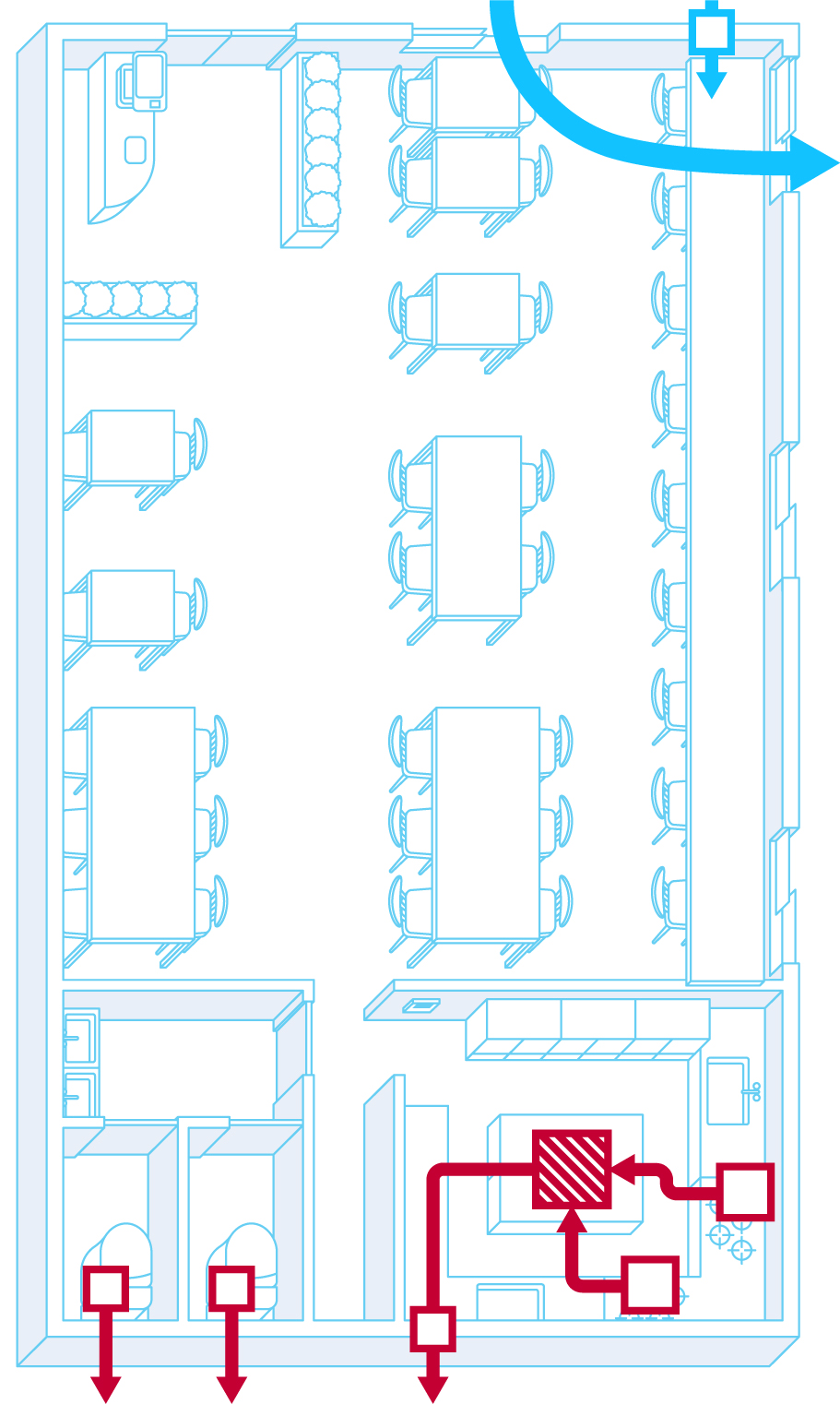
For difficulties in letting a breeze inside even when windows are open

For rooms without a window
When a room has no windows such as a private room of a restaurant, you need to first check the locations of the ventilation vents (air exhaust) on the ceiling. Opening the room door and placing fans or air circulators in the room will help send the flow of air outside the room.
Example ①: For stores where the ventilation vent (air exhaust) is outside the room (private room)
When the ventilation vent (air exhaust) is outside the room, open the door and use a fan to send air OUTSIDE the room.
※In this case, having either fans or air circulators both inside the private room and just outside the door is more effective.
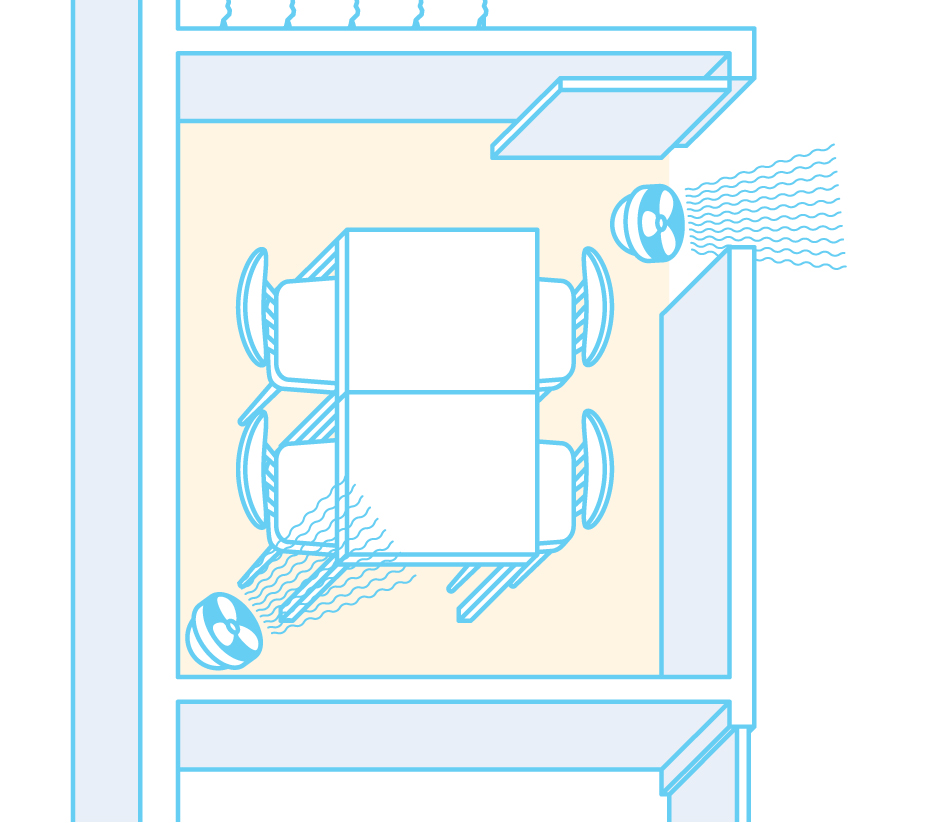
Example ②: For stores where the ventilation vent (air exhaust) is inside the room (private room)
When the ventilation vent (air exhaust) is inside the room (private room), open the door and use a fan to send air INSIDE the room.
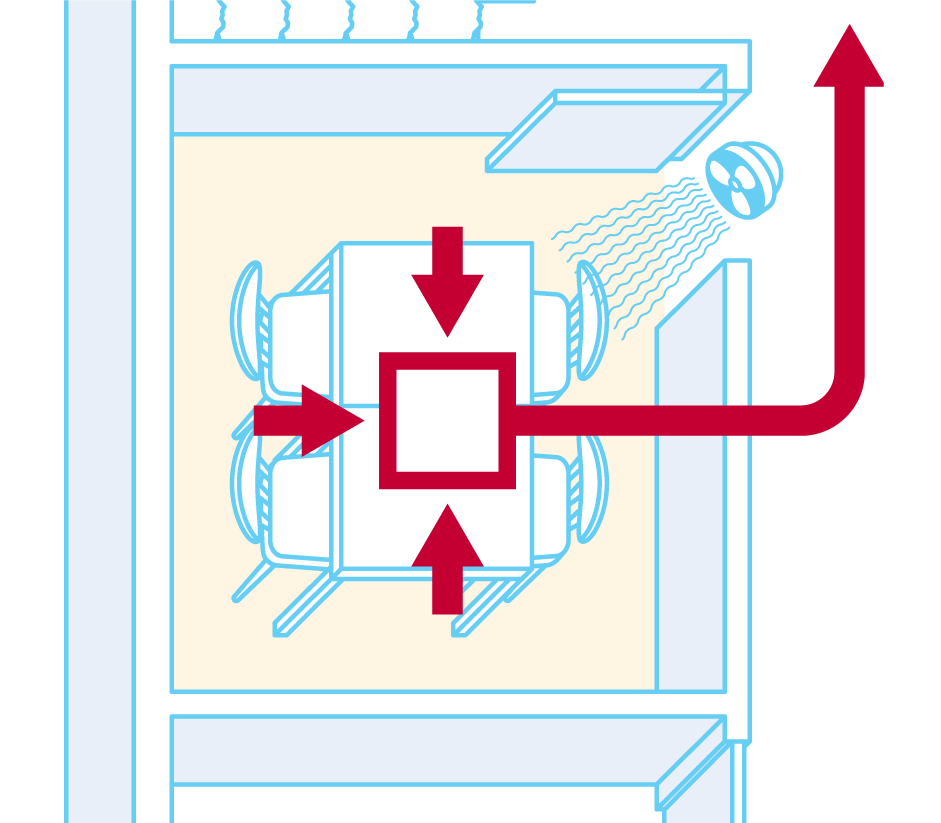
2.Small to Medium-sized Offices <Offices located in small and medium-sized buildings with 10 floors or less>
Generally speaking, in small- to medium-sized offices in building with 10 floors or less, either a tenant company employee operates the ventilation equipment with a remote controller or the building management company operates the ventilation equipment exclusively.
①Check the ventilation equipment installed
First, determine the type of ventilation equipment installed, the location of the remote controller, ventilation equipment, and ventilation vents and understand how the room is ventilated.
Medium-sized Office

① Remote controller switch ② Ventilation hood ③ Ventilation vent (exhaust) ④ Door vent ⑤ Vent / Vent cap ⑥ Heat reclaim ventilator
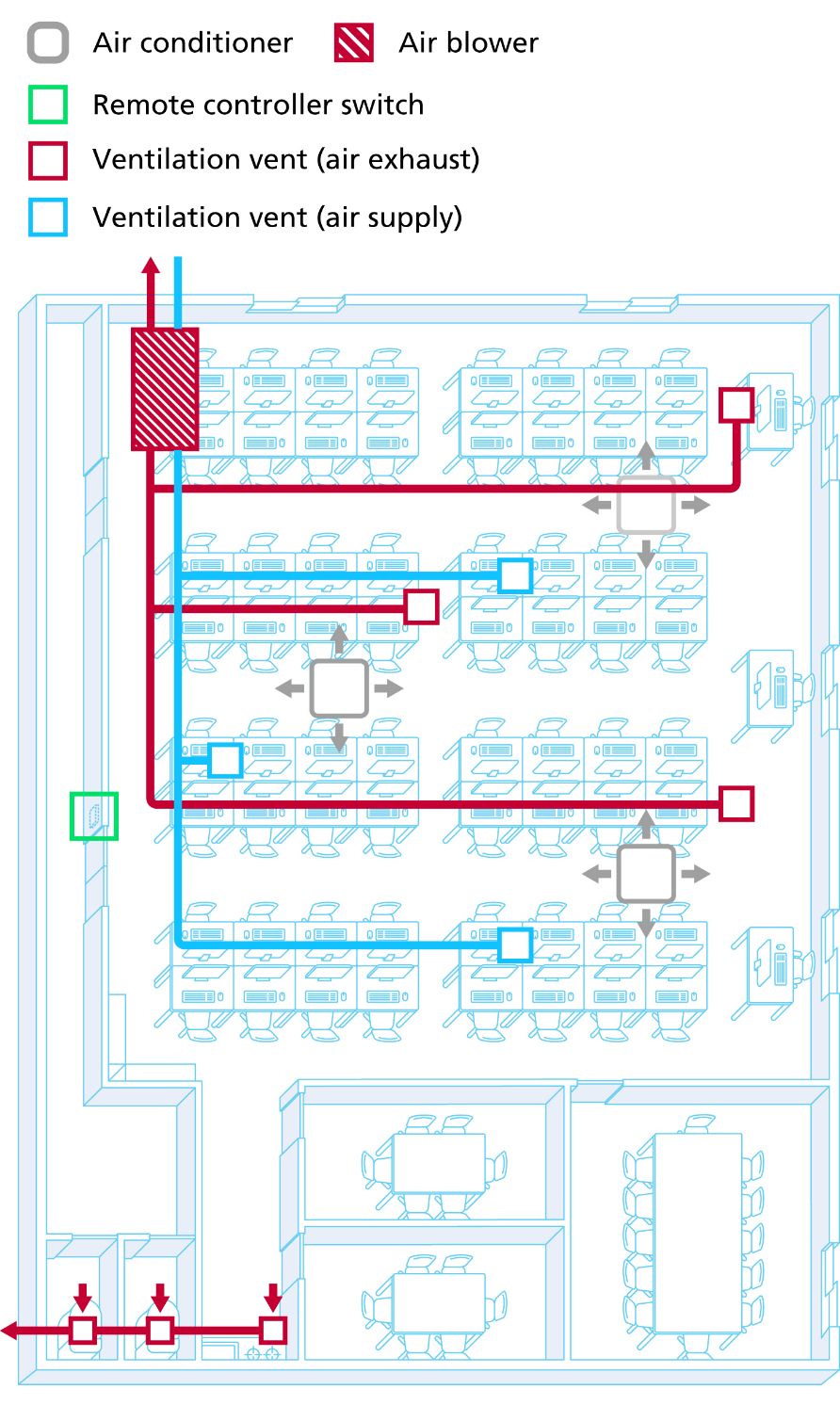
Small-sized Office

① Remote controller switch ② Ventilation hood ③ Ventilation vent (exhaust) ④ Door vent ⑤ Vent / Vent cap ⑥ Heat reclaim ventilator

Perform periodic cleaning and maintenance
In medium-sized offices, air conditioning and ventilation equipment are often operated by a building management company. It is important for the facility manager in the tenant company to confirm and understand the operation status of the ventilation equipment (time, airflow amount, etc.) and the cleaning and maintenance status.
However, in small-sized office buildings, the tenant companies occupying the offices may be required to manage, clean, and maintain the ventilation equipment themselves. Filters are always installed to the ventilation ducts (enclosed passages for conveying air) behind the ventilation vents on the walls and ceilings and require checking. Compared to air conditioners, people are less likely to be aware of the effect of ventilation equipment and may not even notice a decrease in ventilation capacity through maintenance neglect such as failing to replace air filters.
Ventilation efficiency decreases when filters are clogged, so clean filters regularly.
As a guideline※, filters should be inspected once a month for cleanliness and condition and replaced once a year. Because filters prevent outside insects from coming indoors and protect ventilation equipment , never operate with the filters unattached.
※Reference: Consult with an HVAC specialist on recommended periodic maintenance and inspection (Japan Refrigeration and Air Conditioning Industry Association) to ensure long-life service and confidence for the heat reclaim ventilators.
Consult with a specialist
If you have any problems in the operation, maintenance, or cleaning of the ventilation equipment, be sure to consult an HVAC specialist.
②Create an air passage by opening windows and entrance doors
Using ventilation equipment with windows and doors open
In offices, the layout and partitions often change, and the airflow assumed at system installation may not be as effective for the current situation. For this reason, uneven temperatures and air stagnation can easily occur in a variety of places. In small- to medium-sized offices, you can reliably and effectively change the air in buildings by using the ventilation equipment together with opening windows and entrance doors.
The standard length of time and frequency to ventilate a building by opening windows is about 10 minutes every hour. The effect becomes even higher when ventilation is performed twice for five minutes every hour than when it is performed once for ten minutes every hour. In other words, the more often you ventilate, the greater improvement you will see in effectiveness. We recommend ventilating before the start of business hours and during breaktime.
Method for opening windows (and doors) to create an air passage
When ventilation is performed by opening windows, it is better to open two windows instead of one in order to create an air passage for efficient ventilation. It is even more efficient if the two windows are diagonal to each other.
Good example: It is efficient to open windows that are diagonal to each other.
For a medium-sized office
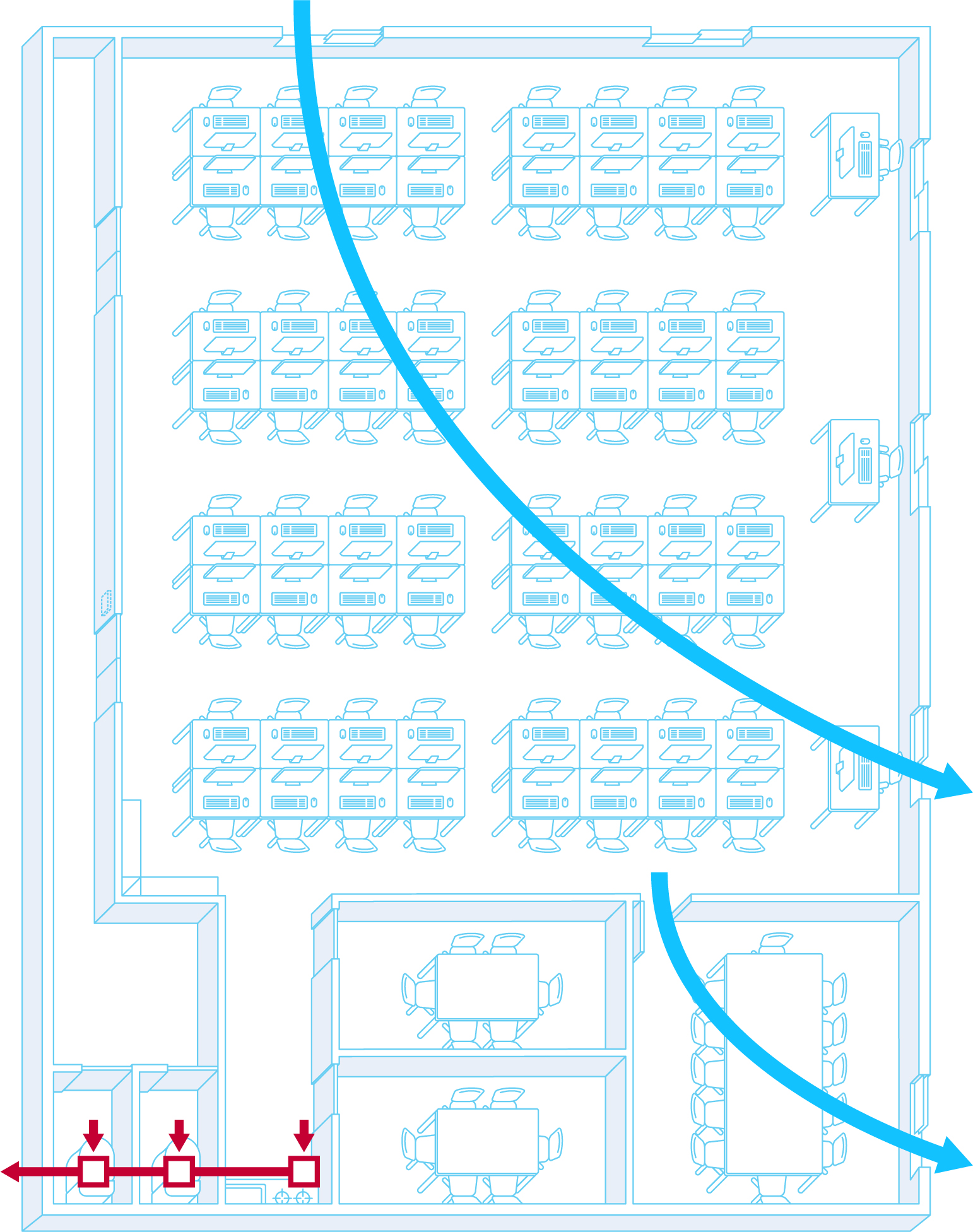
For a small-sized office
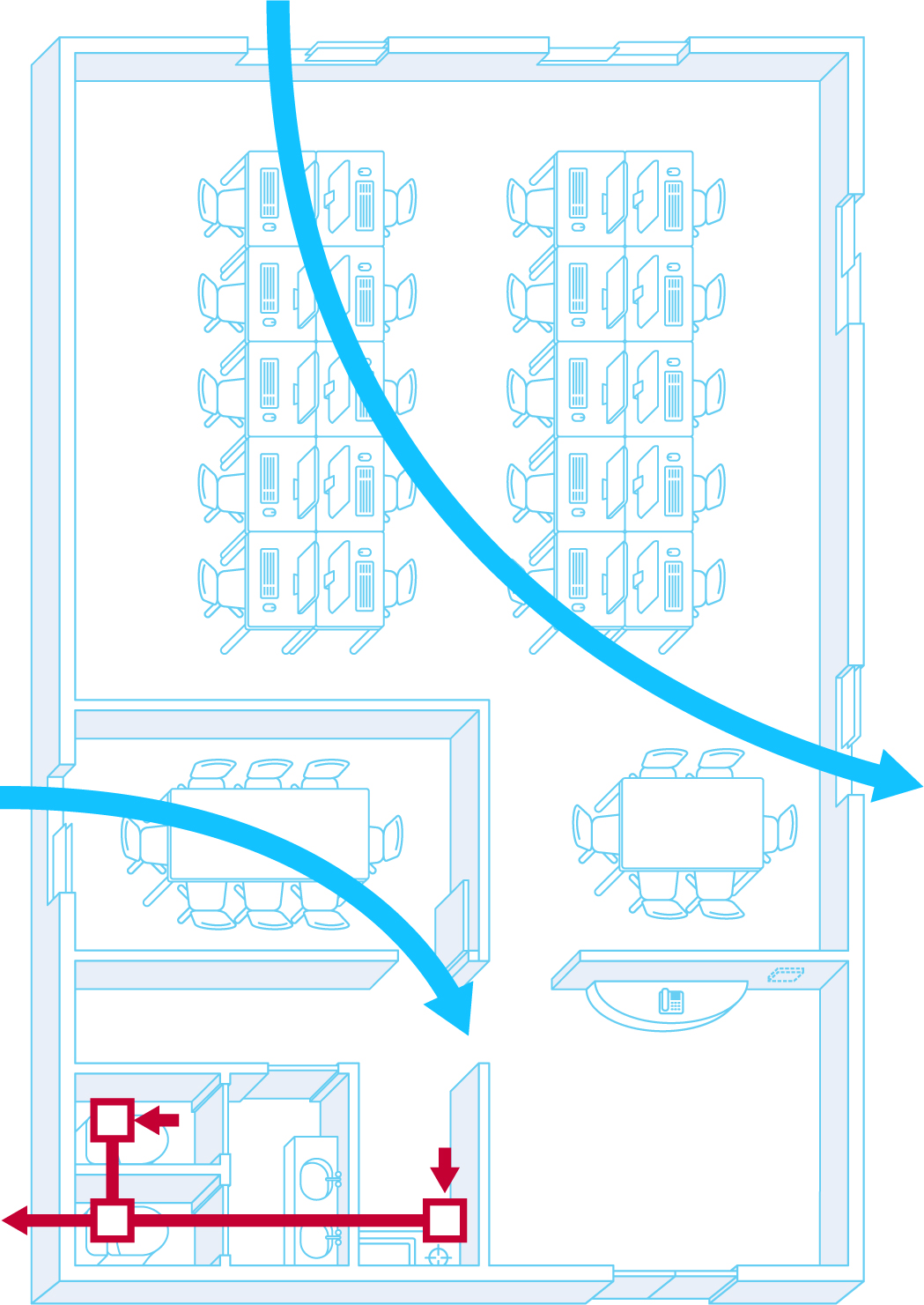
Opening two windows positioned closely to each other will prevent air from flowing through the entire room.
Bad example: Inefficiency results from opening nearby windows due to the small area in which air circulates.
For a medium-sized office
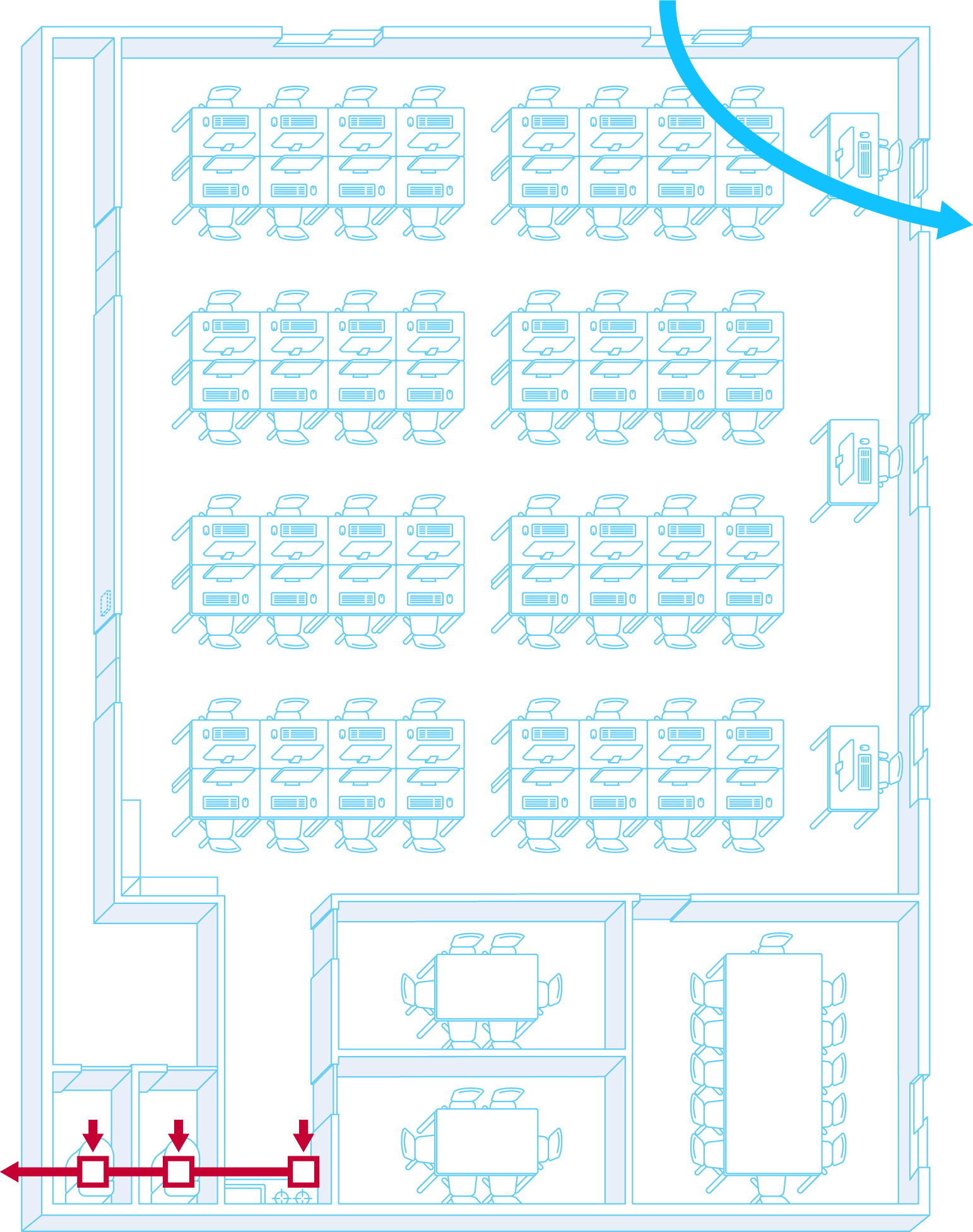
For a small-sized office

For difficulties in letting a breeze inside even when windows are open
When you feel that the room has low airflow, try partially opening the window supplying air while opening the window discharging air much wider. This will increase ventilation efficiency since a smaller opening for air supply causes air to flow more forcefully. In this way, narrowing the opening for the air inlet and widening the opening for the air outlet helps mix the indoor air and ventilate the air over a larger area of the room.

For rooms without a window
When a room has no windows such as a conference room, you need to first check the locations of the ventilation vents (air exhaust) on the ceiling. Opening the room door and placing fans or air circulators in the room will help send the flow of air outside the room.
Example ①: For offices where the ventilation vent (air exhaust) is outside the room/conference room
When the ventilation vent (air exhaust) is outside the room, open the door and use a fan to send air OUTSIDE the room.
※In this case, having either fans or air circulators positioned both inside the conference room and just outside the door is more effective.
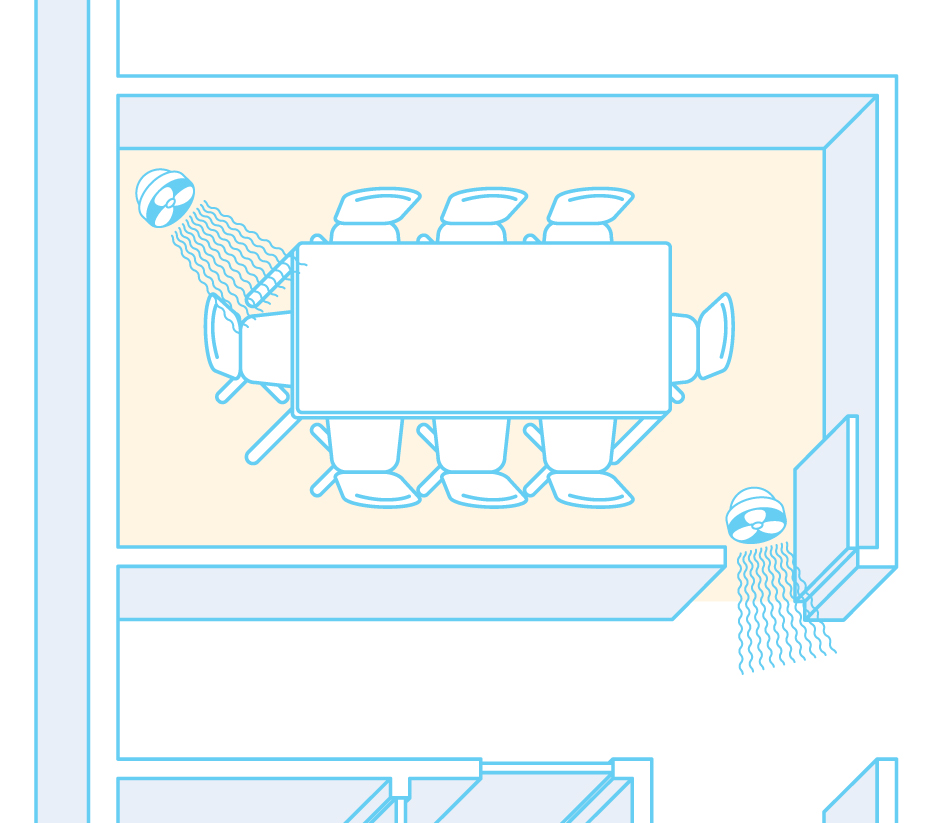
Example ②: For offices where the ventilation vent (air exhaust) is inside the room/conference room
When the ventilation vent (air exhaust) is inside the room/conference room, open the door and use a fan to send air INSIDE the room.

■Experimental data: CO2 concentration in conference rooms
Closed conference rooms are especially susceptible to air stagnation. In a long meeting or a meeting with a large number of people, the CO2 concentration in the room quickly increases from the exhaled breath of each person, and this CO2 build-up leads to lapses in mental concentration. In order to quickly ventilate a meeting room, operate the ventilation equipment together with opening the windows and doors.
Changes in CO2 concentration in a Conference Room

3.Offices and Stores in Large Buildings with Closed Windows
In large buildings where windows remain closed, such as office and commercial buildings, ventilation is effectively performed by ventilation systems. In large spaces, ventilation is more efficiently performed with large machinery. For this reason, ventilation equipment is installed in a mechanical room that is inaccessible to the general public and is used only by the building management company.
There is no need to wonder whether there is adequate ventilation even if the windows are always closed.
For office and commercial buildings, the Japanese Building Standards Act stipulates that a building must be equipped with sufficient ventilation capacity to protect the health of the building occupants, even when a building is crowded.
Nevertheless, operation of ventilation equipment differs for each building. Ventilation operates at a set time by a predetermined schedule based on the presence of people: for example, from 9 am to 6 pm. Depending on the time of day, the ventilation system may not be in operation. When working irregular hours or on holidays, you should confirm operation with the facility manager in your company or the building management company to ensure that you have adequate ventilation while working.

Check items for ventilation equipment
①Installation location and type of ventilators and ventilation equipment (ventilation vents: air exhaust vents, air supply vents, etc.)
… Living space / offices, conference rooms, reception rooms, executive rooms, changing rooms, hot water supply rooms, restrooms, etc.
②Operating hours for ventilation equipment (weekdays / holidays)
③Amount of ventilation set for ventilation (weekdays / holidays)
④Ventilation equipment maintenance times and schedule
⑤Schedule and cycle for cleaning and replacing filters
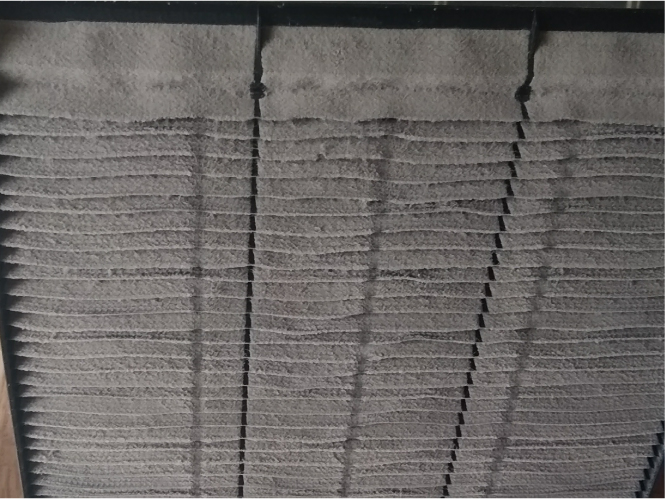
Dirty filter
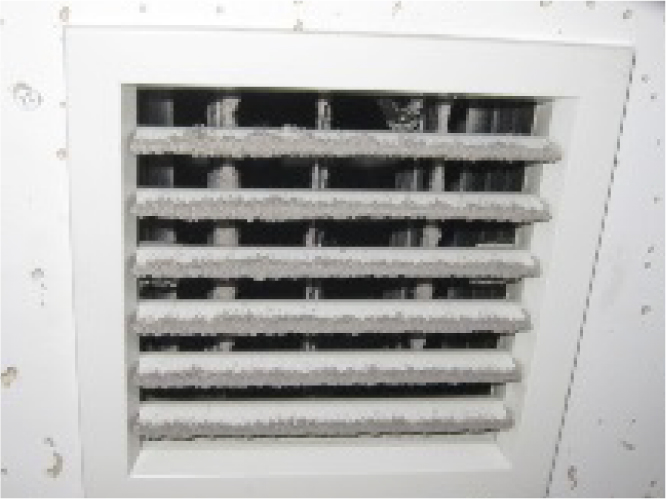
Dirty ventilation vent
(air exhaust vent/air supply vent)
In offices, sometimes many people assemble in conference rooms and cafeterias causing stale air and pollutants to temporarily increase. In these situations, we recommend increasing ventilation. Please refer to the ventilation method mentioned in “2. Small to Medium-sized Offices <Offices located in small and medium-sized buildings with 10 floors or less>”
Also, even in large buildings with no windows, when there is a remote controller for the air conditioner or ventilation equipment in the room, it is necessary for the occupants to manage the ventilation themselves. Refer to “2. Small to Medium-sized Offices <Offices located in small and medium-sized buildings with 10 floors or less>” for useful advice.
Summary of Ventilation Methods for Offices and Stores
When ventilating an office or store, it is best to first check what type of ventilation equipment is installed and know how to properly use it to ventilate the indoor space. However, depending on such factors as the time of day, number of people assembled, change in office partitions, and cleanliness of filters, you may experience inadequate ventilation. Using a method introduced here, you can create airflow and effectively ventilate the indoor space to match the work environment and building design. For conferences rooms and other closed spaces, maintaining proper ventilation by opening the door before the start and after a meeting is a good routine to follow.
Decide and implement “ventilation rules for office rooms”
If window ventilation is possible for your office, why not establish ventilation rules and practice daily ventilation by rotating responsibility for executing those rules. By opening the windows before starting work each morning and letting out all of the trapped indoor air that had accumulated overnight, you can start each day in a healthy and pleasant work environment. Especially on Mondays during the summers when hot, stagnant air has collected over the weekend, ventilating the room before turning on the air conditioner will help save electrical power by lowering the room temperature.
Decide and implement “ventilation rules for conference rooms”
We recommend deciding and implementing ventilation methods for when people enter and leave the conference rooms.
For example, ventilate a room by opening the door for a few minutes every hour or when the meeting is over and there is no one in the room. Deciding and implementing simple rules, such as always leaving the door open when a meeting is over, leads to a good routine for ventilation.
My ventilation rules for the conference rooms (example)
“Changing the air at the same time as the members change”
- Make sure to open the door for 10 minutes in a one-hour meeting.
- Be sure to leave the door open when you leave the room after a meeting.
- Open the doors of each conference room every day at the end of work and when leaving the office.
Daikin, as a company that provides solutions with air, will continue to bring comfortable air and confidence to customers around the world while pursuing the new possibilities of air and conveying its importance.
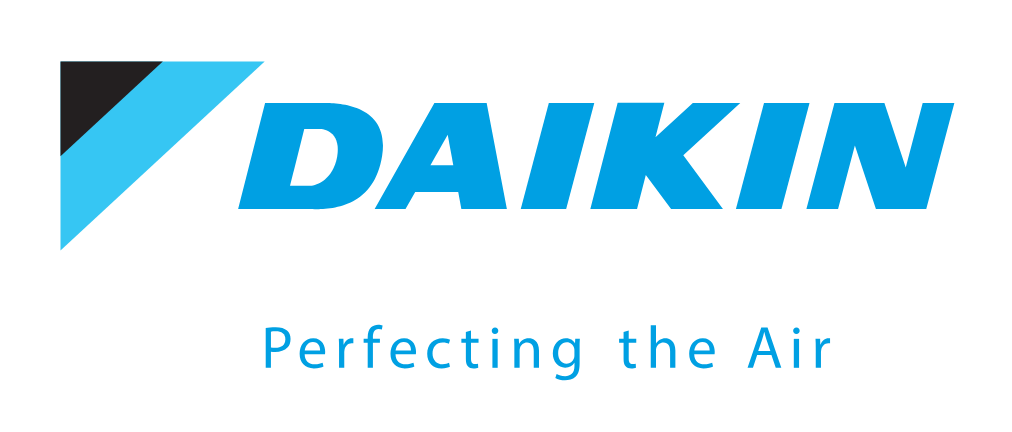
 EN
EN







